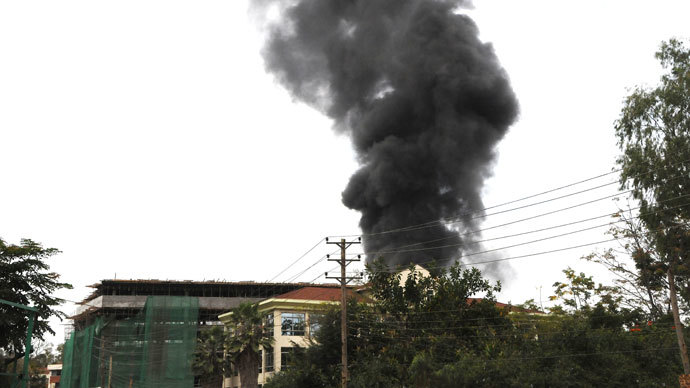Nairobi tragedy: Carnage foretold

They had warned they would attack, and they kept their word. Since the Kenyan invasion of Somalia on 16 October 2011, Al-Shabaab have repeatedly threatened to strike against ‘tall buildings’ in Nairobi.
Al-Shabaab considers it legitimate retaliation for scores of civilians killed by Kenyan armed forces operating in southern Somalia.
The assault came on 21 September 2013, when a heavily armed unit of Al-Shabaab drove their ordinary looking car to the entrance of Nairobi’s upmarket Westgate shopping mall, then fought their way inside, spraying the lobby with machinegun fire, and throwing hand grenades. Hundreds of Saturday shoppers were immobilized by horror. Many people died during the first hour.
Muslims were allowed to leave, but first they had to prove their faith by reciting parts of the Koran. Those who couldn’t, were shot - executed at point blank range, on the spot. Children who were trying to escape, some as young as 5, were killed. Then hostages were taken, perhaps several hundreds of them.
The most luxurious shopping center in East Africa was turned into a killing field, in just a tiny fraction of that ill-fated morning.
Ms Mitsue Uemura, UNICEF Regional Education Specialist, was there, and later she recalled:
“My family and I were at the Westgate Mall in the late morning of Saturday. We had spent a lot of time browsing through books at the bookstore located on the 1st floor. Then all of a sudden, we heard and felt several powerful explosions from down below, as well as from above us, but we were not sure what they were, at first. People began running around and trying to get out and I heard screams, and suddenly there was so much commotion all around us. We were stranded for two hours but in the end we were safely escorted out of the mall by the police.”
They were lucky. Suveer, a young dentist who later saved many lives by leading the army into the besieged mall, told me on Monday morning:
“What I saw around me was shocking… On the ground floor, at Dorman’s Café, there were still cups of espresso and cappuccino on the tables. They were intact. But all around, people were dead, scattered all over the floor.”
Bleeding Somalia
The madness and brutality of the attack shook the world. The images of terrified people, of blood and smoke, of Kenyan armed forces and heavily armed police, inundated television sets in Europe, North America, everywhere.
Unfortunately, most of reports took the attack totally out of the complex and cruel East African context.

Somalia is bleeding. It has been destabilized for years and decades, invaded by several countries including Ethiopia and Kenya, on behalf of Western powers and interests.
Already in 2010, one year before the invasion by Kenya of Somalia, my friend and a Kenyan opposition leader Mwandawiro Mghanga, head of the Social Democratic Party and former MP, predicted trouble:
“…Look at our foreign policy, our involvement with Somalia on behalf of the United States. The way it is going right now, it can only cause us much harm. We are the ones who will pay the big price for following instructions and defending U.S. interests in the region… Another factor that makes it so important is that this part of the world, particularly Somalia is suspected of having an enormous amount of oil under the ground. It is not being explored due to the security situation, but it is there. There is plenty of oil even in northern Kenya near the Somali border, another strategic area.”
Mr. Mwandawiro then informed me about several attempts made in the past by Kenyan politicians to broker peace agreements inside Somalia. He explained how the West torpedoed them.
One year later, several aid workers and tourists were kidnapped from the Dadaab refugee camps (built predominately for Somali refugees), and from the coast.
The kidnappings were clearly a well-orchestrated prelude to the invasion. Later, the Guardian reported on 8 November 2011:
“…The Kenyan intervention plan was discussed and decided in 2010, then finalized with input from western partners, including the US and to a lesser extent France", with Nairobi using the kidnappings "as an excuse to launch an operation ready and waiting.”
I investigated further, in both Dadaab refugee camps and around the city of Lamu on the coast, coming to conclusions that there was absolutely no proof that Al-Shabaab was involved in any of the kidnappings. Its leaders strongly denied any participation. Several international workers at Dadaab camps went as far as claiming that the kidnappings were done by the Kenyan government itself, a belief widely shared by people living in coastal communities.

One of the official justifications of the Kenyan invasion was the alleged request from the then Transitional Federal Government (TFG) of Somalia. But as the Kenyan troops first entered Somali territory north of the border, even the Western-backed TFG began protesting against the invasion, and the TFG’s Somali President Sharif Sheikh Ahmed declared that his “administration and people in Somalia opposed the presence of Kenyan troops since the Somalian federal government ‘had no agreement with Kenya beyond helping us with logistics’”, as was reported by ABC News (Australia) on October 25, 2011.
Western ally
Kenya is a staunch Western ally in the region. Not only is it now occupying part of Somalia (it is presently helping to establish oil-rich Jubba Land as an autonomous entity, or some sort of ‘protectorate’), but also it is deeply involved in the newly independent South Sudan.
It is a well-known fact that it is hosting Western military bases on its territory. There are British bases as well as the alleged presence of Israeli intelligence personnel.
Global Security informed:
“As early as 2005 it was reported that American troops were deployed to Lamu, Kenya, as part of the 1,500-strong Combined Joint Task Force Horn of Africa. With the Somali border about 100 kilometers north of Lamu, US officials were eager to accept Kenya's invitation to bolster their sea and land defenses. At times American troops marched in full combat gear through Lamu's narrow lanes in a show of force. The coastal town of Lamu is frequently the site of large joint Kenyan-US military exercises. The US has built a military air base at Manda Bay in Kenya. US troops are stationed inside Camp Simba, a Kenyan naval base located on that country's sandy coast.”
While working on the islands between Lamu and the Somali border, I was told by fishermen that there was fear in local communities, and that people were being kidnapped and interrogated by speedboat crews consisting of both Kenyan and Western looking soldiers.

Destabilized Somalia then sends hundreds of thousands of refugees to all corners of the world, but mainly across the border to Kenya. I wrote and directed a feature-length documentary film “One Flew Over Dadaab”, addressing the plight of people in the largest refugee camp on earth (two years ago hosting over 500,000 people living there, now much more), where an entire young generation of refugees never saw anything else other than desert sand, dry bushes and barbed wire.
In Dadaab and elsewhere, I was told countless stories about the brutality of the Kenyan forces in Somalia. But there is no access to Jubba Land now; no way to verify reports and eyewitness accounts. The entire area is sealed off.
Brutality without borders
All this naturally does not justify the attacks, the brutality and savagery of the strike.
But it clearly illustrates that the entire area is sick, it is damaged, in agony.
People do not throw grenades at each other in a normal state of mind; they don’t do it out of happiness.
As I stood at the entrance to Westgate, on Sunday night, a Kenyan Indian man with bloodshot eyes was screaming at the soldiers:
“My wife is there, inside… And my 2-year-old son! My wife is probably dead! What have you been doing? Let me in! Let me go and find them!”
It was raining hard. The soldiers were trying to calm him down, but his desperation had no limits. Tears were rolling down his face, and at one point he broke free and in total despair he ran towards the Westgate and into the night.
The stories around the Westgate are heartrending.
The two days that I spent covering this conflict, there were loud explosions and gunfire, bullets flying, perhaps too near.
There was speculation as to whether the leader of the attack is that British woman, the so called “White Widow”, who lost her husband during the terrorist attack on the London underground.
Finally, today, on Tuesday, the Kenyan government announced that there is one British citizen and two American citizens participating in the attack.

And there has been countless speculation, and even confirmation that both the Israeli and the US forces are participating in the action to retake the mall.
There was also speculation about the number of fighters, about the number of Kenyan soldiers who have died (I was confidentially told that their number was six), about the hostages who died. Is the number 68 or 69? How many were injured, is it 200 or more?
And I keep thinking, standing in the rain as if waiting for something, or falling to the ground avoiding bullets… I am thinking: does it really matter? 68 or 69 or 75; are exact numbers what this is all about?
Nobody talks about the essence. What is happening to Somalia and what is happening to Kenya? Why is East and Central Africa once again screaming, and crushed by Western imperialism?
Nobody talks about the hundreds of thousands of those who have been dying in Somalia, about the millions of ruined lives. Nobody talks about close to 10 million who have already died in DR Congo. What role is Kenya playing in allowing the militarization of this part of the world, by so closely cooperating with the former colonial masters?
***
It is Tuesday and the Kenyan police declares loudly: “We Have triumphed!”
Earlier, the government says “there are no hostages inside the compound, anymore.”
The Army is boasting that it is in control of all the floors of the Westgate.
Still, helicopters are circling above the compound and there are explosions and new troops pouring into the mall.
One could never be certain. But what we know is perhaps enough to imagine the big picture:
Destabilized by the West, Somalia was invaded by Kenyan forces in 2011. Thousands of innocent people have since died. Thousands of very poor, mostly desperate people have vanished, far away from film and still cameras. Then, one luxury mall in the center of Nairobi has been attacked and around one hundred people have been killed. There are film crews and reporters from all over the world now, and the news is beamed to television screens in the households all over the world.

Because these are people, real people; people that deserve our sympathy and our attention! Many members of the expatriate community had been frequenting the Westgate Mall, including UN staff, diplomats and businessmen.
Those dying across the border are, to use George Orwell’s language, ‘unpeople”. Their life or death means nothing to the television viewers.
As always, we are only allowed to see one half of the story. And in case of the Westgate tragedy, even that half could be observed only from a substantial distance.
Andre Vltchek is a novelist, filmmaker and investigative journalist. He has covered wars and conflicts in dozens of countries. He can be reached through his website or his Twitter.
The statements, views and opinions expressed in this column are solely those of the author and do not necessarily represent those of RT.
The statements, views and opinions expressed in this column are solely those of the author and do not necessarily represent those of RT.













